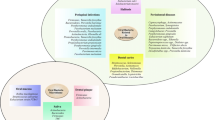Abstract
Previous work showed that a single application of 40% chlorhexidine varnish, EC40®, reduced plaque acidogenicity upon sucrose challenge during less than 3 weeks. It was questioned whether lactic acid production could be reduced significantly longer when the treatment was intensified. Therefore, the effects of three consecutive EC40® applications on plaque acidogenicity were evaluated. Nine subjects who participated in the previous study received three full mouth EC40® applications within 1 week. Before the first application and up to 9 weeks after the third application, plaque samples were taken after a 10% sucrose rinse and analyzed for organic acids with capillary electrophoresis. At baseline, the mean provoked lactic acid concentration was 1.64 (±0.69) μmol/mg protein. At the first and seventh day after the third application, there was too little plaque to measure acid concentrations. At 2 weeks after the third application, lactic acid concentrations were significantly reduced (p < 0.05). The acid concentrations 3 weeks after the third application (1.61 (±0.99) μmol/mg protein) did not differ from the values at baseline (paired T test, p > 0.05). We conclude that a triple 40% chlorhexidine varnish treatment did not affect plaque acidogenicity for more than 3 weeks. From comparison with a previous study, we conclude that the triple treatment with EC40® within 1 week was not more effective in reducing plaque acidogenicity than the single one.


Similar content being viewed by others
References
Bradford MM (1976) A rapid and sensitive method for the quantification of microgram quantities of protein utilizing the principle of protein-dye binding. Anal Biochem 72:248–254
Bratthall D, Serinirach R, Rapisuwon S et al (1995) A study into the prevention of fissure caries using an antimicrobial varnish. Int Dent J 45:245–254
Damen JJ, Buijs MJ, ten Cate JM (2002) Acidogenicity of buccal plaque after a single rinse with amine fluoride–stannous fluoride mouthrinse solution. Caries Res 36:53–57
Emilson CG, Lindquist B, Wennerholm K (1987) Recolonization of human tooth surfaces by Streptococcus mutans after suppression by chlorhexidine treatment. J Dent Res 66:1503–1508
Emilson CG, Lindquist B (1988) Importance of infection level of mutans streptococci for recolonization of teeth after chlorhexidine treatment. Oral Microbiol Immunol 3:64–67
Emilson CG (1994) Potential efficacy of chlorhexidine against mutans streptococci and human dental caries. J Dent Res 73:682–691
Fennis-le YL, Verdonschot EH, Burgersdijk RC, Konig KG, van’t Hof MA (1998) Effect of 6-monthly applications of chlorhexidine varnish on incidence of occlusal caries in permanent molars: a 3-year study. J Dent 26:233–238
Gerardu VA, Buijs MJ, ten Cate JM, van Loveren C (2003) The effect of a single application of 40% chlorhexidine varnish on the numbers of salivary mutans streptococci and acidogenicity of dental plaque. Caries Res 37:369–373
Heintze SD, Twetman S (2002) Interdental mutans streptococci suppression in vivo: a comparison of different chlorhexidine regimens in relation to restorative material. Am J Dent 15:103–108
Ie YL, Schaeken MJ (1993) Effect of single and repeated application of chlorhexidine varnish on mutans streptococci in plaque from fissures of premolar and molar teeth. Caries Res 27:303–306
Maltz M, Zickert I, Krasse B (1981) Effect of intensive treatment with chlorhexidine on number of Streptococcus mutans in saliva. Scand J Dent Res 89:445–449
Marsh PD (1993) Antimicrobial strategies in the prevention of dental caries. Caries Res 27(Suppl 1):72–76
Petersson LG, Magnusson K, Andersson H, Almquist B, Twetman S (2000) Effect of quarterly treatments with a chlorhexidine and a fluoride varnish on approximal caries in caries-susceptible teenagers: a 3-year clinical study. Caries Res 34:140–143
Sandham HJ, Brown J, Phillips HI, Chan KH (1988) A preliminary report of long-term elimination of detectable mutans streptococci in man. J Dent Res 67:9–14
Sandham HJ, Brown J, Chan KH, Phillips HI, Burgess RC, Stokl AJ (1991) Clinical trial in adults of an antimicrobial varnish for reducing mutans streptococci. J Dent Res 70:1401–1408
Sandham HJ, Nadeau L, Philips HI (1992) The effect of chlorhexidine varnish treatment on salivary mutans streptococcal levels in child orthodontic patients. J Dent Res 71:32–35
Schaeken MJ, De Haan P (1989) Effects of sustained-release chlorhexidine acetate on the human dental plaque flora. J Dent Res 68(2):119–123
Schaeken MJ, Schouten MJ, van den Kieboom CW, van der Hoeven JS (1991) Influence of contact time and concentration of chlorhexidine varnish on mutans streptococci in interproximal dental plaque. Caries Res 25:292–295
Schaeken MJ, van der Hoeven JS, van den Kieboom CW (1994) Effect of chlorhexidine varnish on streptococci in dental plaque from occlusal fissures. Caries Res 28:262–266
Twetman S, Petersson LG (1997) Effect of different chlorhexidine varnish regimens on mutans streptococci levels in interdental plaque and saliva. Caries Res 31:189–193
Twetman S, Petersson LG (1999) Interdental caries incidence and progression in relation to mutans streptococci suppression after chlorhexidine–thymol varnish treatments in schoolchildren. Acta Odontol Scand 57:144–148
Acknowledgements
We express our gratitude to the volunteers who participated in this trial.
Author information
Authors and Affiliations
Corresponding author
Rights and permissions
About this article
Cite this article
Gerardu, V.A.M., Buijs, M.J., ten Cate, J.M. et al. Effect of an intensified treatment with 40% chlorhexidine varnish on plaque acidogenicity. Clin Oral Invest 11, 77–81 (2007). https://doi.org/10.1007/s00784-006-0079-7
Received:
Accepted:
Published:
Issue Date:
DOI: https://doi.org/10.1007/s00784-006-0079-7



